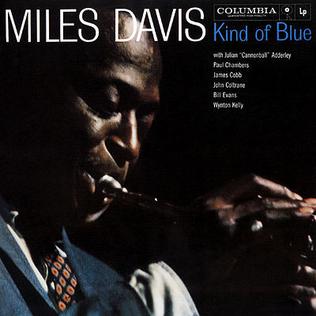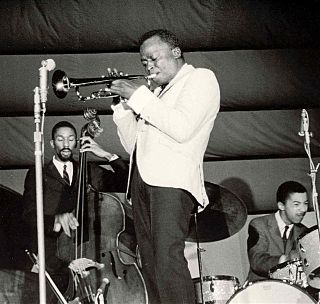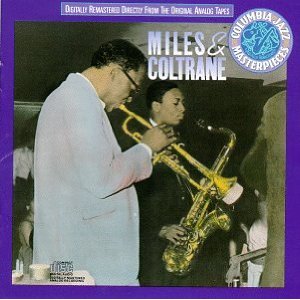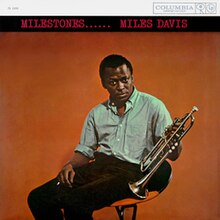
Kind of Blue is the fifth studio album released on Columbia, and twenty-eighth overall, by American jazz musician, trumpeter, composer, and bandleader Miles Davis. It was recorded on March 2 and April 22, 1959, at Columbia's 30th Street Studio in New York City, and released on August 17 of that same year by Columbia Records. For the recording, Davis led a sextet featuring saxophonists John Coltrane and Julian "Cannonball" Adderley, pianist Bill Evans, bassist Paul Chambers, and drummer Jimmy Cobb, with new band pianist Wynton Kelly appearing on one track – "Freddie Freeloader" – in place of Evans.

Somethin' Else is a jazz album by alto saxophonist Julian "Cannonball" Adderley, his only album on the Blue Note label, recorded and released in 1958. Also on the session is trumpeter Miles Davis in one of his handful of recording dates for Blue Note. Adderley was a member of Davis' group at the time, and the album was recorded shortly after Davis' own landmark album Milestones. The Penguin Guide to Jazz selected Somethin' Else as part of its suggested "Core Collection."

William McKinley "Red" Garland Jr. was an American modern jazz pianist. Known for his work as a bandleader and during the 1950s with Miles Davis, Garland helped popularize the block chord style of playing in jazz piano.

'Round About Midnight is an album by jazz trumpeter Miles Davis that was originally released by Columbia Records in March 1957. It was Davis' first album with Columbia.

Someday My Prince Will Come is the seventh studio album by Miles Davis for Columbia Records, catalogue CL 1656 and CS 8456 in stereo, released in 1961. Recorded at Columbia's 30th Street Studio in Manhattan, New York City, it marked the only Miles Davis Quintet studio recording session to feature saxophonist Hank Mobley.

Porgy and Bess is a studio album by jazz musician Miles Davis, released in March 1959 on Columbia Records. The album features arrangements by Davis and collaborator Gil Evans from George Gershwin's 1935 opera of the same name. The album was recorded in four sessions on July 22, July 29, August 4, and August 18, 1958, at Columbia's 30th Street Studio in New York City. It is the second collaboration between Davis and Evans and has garnered much critical acclaim since its release, being acknowledged by some music critics as the best of their collaborations. Jazz critics have regarded the album as historically important.

Miles Davis and Milt Jackson Quintet/Sextet, also known as Quintet/Sextet is a studio album by trumpeter Miles Davis and vibraphonist Milt Jackson released by Prestige Records in August of 1956. It was recorded on August 5, 1955. Credited to "Miles Davis and Milt Jackson", this was an "all-star" session, and did not feature any of the members of Davis's working group of that time. Alto saxophonist Jackie McLean appears on his own compositions “Dr. Jackle” and “Minor Apprehension”.
"Milestones" is a jazz composition written by Miles Davis. It appears on the album of the same name in 1958. It has since become a jazz standard. "Milestones" is the first example of Miles composing in a modal style and experimentation in this piece led to the writing of "So What" from the 1959 album Kind of Blue. The song's modes consist of G Dorian for 16 bars, A Aeolian for another 16 bars, and then back to G Dorian for the last eight bars, then the progression repeats.

Miles & Monk at Newport is a split album featuring separate performances by the Miles Davis sextet and the Thelonious Monk quartet at the Newport Jazz Festival, recorded in 1958 and 1963, respectively, and released in June 1964 by Columbia records. Despite the album's title, the two artists do not perform together at either date.

Settin' the Pace is an album by jazz musician John Coltrane, released in December 1961 by the Prestige label. It is assembled from previously unissued tracks from a recording session at the studio of Rudy Van Gelder in Hackensack, New Jersey in 1958. Coltrane on tenor saxophone is accompanied by Red Garland on piano, Paul Chambers on bass, and Art Taylor on drums. With Garland and Chambers, Coltrane had played together since at least October 1955 in Miles Davis' band. With Art Taylor they were part of the Tenor Conclave recordings in September 1956. As a quartet they had already recorded two albums for Prestige, John Coltrane with the Red Garland Trio and Soultrane. The material the quartet recorded on this session were extended interpretations of three popular songs and "Little Melonae", a classic bebop tune written by Jackie McLean. Of note is Coltrane's use of the sheets of sound technique, particularly on "Little Melonae".

The Complete Columbia Recordings of Miles Davis with John Coltrane is a box set featuring jazz musicians Miles Davis and John Coltrane. It is the first box set in a series of eight from Columbia/Legacy compiling Davis's work for Columbia Records, and includes never-before-released alternate takes, omissions of other musicians, musician comments, false starts and a first version of compositions, some of which have made it to the 50th Anniversary 2-disc CD version of Kind of Blue. Originally issued on April 11, 2000, in a limited-edition metal slipcase, it was reissued in 2004 in an oversized book format. In conjunction with Sony, Mosaic Records released the 9-LP set.

The Miles Davis Quintet was an American jazz band from 1955 to early 1969 led by Miles Davis. The quintet underwent frequent personnel changes toward its metamorphosis into a different ensemble in 1969. Most references pertain to two distinct and relatively stable bands: the First Great Quintet from 1955 to 1959, and the Second Great Quintet from late 1964 to early 1969, Davis being the only constant throughout.

Cool Struttin' is an album by jazz pianist Sonny Clark that was released by Blue Note Records in August 1958. Described as an "enduring hard-bop classic" by The New York Times, the album features alto saxophonist Jackie McLean, trumpeter Art Farmer and two members of the Miles Davis Quintet, drummer Philly Joe Jones and bassist Paul Chambers. According to The Stereo Times, the album enjoys "a nearly cult status among hardcore jazz followers", a reputation AllMusic asserts it deserves "for its soul appeal alone".

1958 Miles is a compilation album by American jazz musician Miles Davis, released in 1974 on CBS/Sony. Recording sessions for tracks that appear on the album took place on May 26, 1958, at Columbia's 30th Street Studio and September 9, 1958, at the Plaza Hotel in New York City. 1958 Miles consists of three songs featured on side two of the LP album Jazz Track, which was released in November 1959, one song from the same session not appearing in the album, and three recordings from Davis' live performance at the Plaza Hotel with his ensemble sextet. The recording date at 30th Street Studio served as the first documented session to feature pianist Bill Evans performing in Davis' group.

Jazz at the Plaza Vol. I is a live album by The Miles Davis Sextet. It was recorded in 1958 and released in 1973 by Columbia Records. Duke Ellington was recorded at the same event and released as the second volume (Jazz at the Plaza Vol. II).

At Newport 1958 is a live album by the jazz musician Miles Davis featuring the Miles Davis Quintet's complete performance recorded at the Newport Jazz Festival in 1958. The album was first released as a single CD in 2001 though four tracks had previously been released in part as one side of the LP Miles & Monk at Newport. The entire concert was given its first complete release as part of The Complete Columbia Recordings of Miles Davis with John Coltrane box set in 1999, and all tracks were included on the 2015 compilation Miles Davis at Newport 1955-1975: The Bootleg Series Vol. 4.

Portrait of Cannonball (1958) is the ninth album by jazz saxophonist Cannonball Adderley, and his first release on the Riverside label, featuring performances by Blue Mitchell, Bill Evans, Sam Jones, and Philly Joe Jones.

Miles & Coltrane is a live album by American jazz musician Miles Davis, released in 1988 by Columbia Records. The music was recorded at two different shows—one on July 4, 1958, at the Newport Jazz Festival, and one from October 27, 1955, in New York. The tracks have been digitally remastered directly from the original analog tapes.

Basic Miles: The Classic Performances of Miles Davis is a compilation album by American jazz musician Miles Davis, released in 1973 by Columbia Records and recorded from 1955 through 1962.
"Nardis" is a composition by American jazz trumpeter Miles Davis. It was written in 1958, during Davis's modal period, to be played by Cannonball Adderley for the album Portrait of Cannonball. The piece has come to be associated with pianist Bill Evans, who performed and recorded it many times.

















